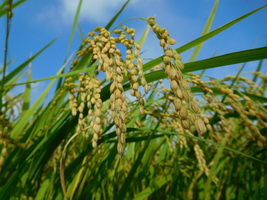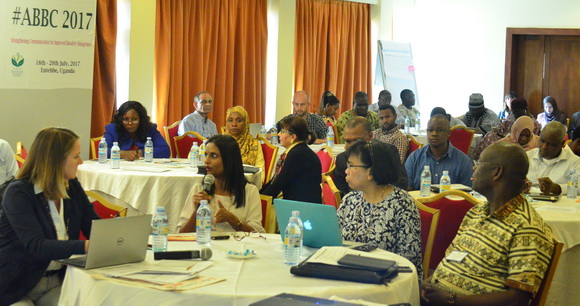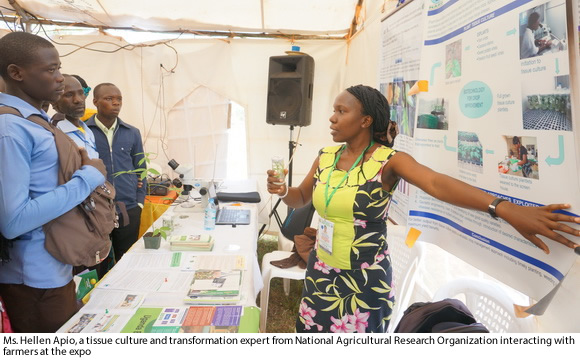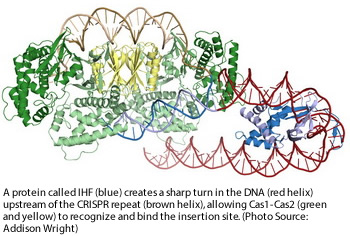CROP BIOTECH UPDATE
---------------------------------------------------------------------------
A weekly summary of world developments in agri-biotech for developing countries, produced by the Global Knowledge Center on Crop Biotechnology, International Service for the Acquisition of Agri-biotech Applications SEAsiaCenter (ISAAA)
---------------------------------------------------------------------------
July 26, 2017
In This Week’s Issue:
News
Global
• Web Portal Established to Speed up Genetic Research in Plants
• India's B.R. Barwale Passes Away
Africa
• African Biosafety Regulators Embrace Biosafety Communication at ABBC 2017
• Biotechnology Praised at the Biggest Agri Expo in Uganda
Americas
• Adoption of GE Crops in the US
• New Gene in Corn Confers Resistance to Multiple Diseases
Asia and the Pacific
• Study Finds Plants Reprogram Their Genetic Material to Fight Pathogens
• China Gives Import Approval for Corn Rootworm Resistant Trait
Europe
• Russia Drafts Regulations for GE Feed
Research
• Overexpression of BoC3H Gene Enhances Salt Stress Tolerance in Broccoli
• Study on the Effect of Light and Temperature on CBF14 Expression in Wheat and Barley
New Breeding Technologies
• CRISPR-Cas9 and CRISPR-Cpf1 Mediated Genome Editing of EPFL9 Gene in Rice
• Discovery on How CRISPR Proteins Identify Targets
Beyond Crop Biotech
• NAS Announces Awards for Science Communication
• Researchers Develop Plant-produced Vaccine Candidates Against Bluetongue Virus
----
NEWS
----
Global
WEB PORTAL ESTABLISHED TO SPEED UP GENETIC RESEARCH IN PLANTS
 Scientists from University of California, Davis and partners successfully completed the first whole-genome sequence of fast-neutron-induced mutations of a model variety of rice known as Kitaake which has a short life cycle of just nine weeks. This collection will help speed up genetic research in rice and other monocots that can be used as biofuels. A web portal called KitBase was launched to allow other researchers to get information related to the mutant collection, such as sequence, mutation, and phenotypic data for each rice line.
Scientists from University of California, Davis and partners successfully completed the first whole-genome sequence of fast-neutron-induced mutations of a model variety of rice known as Kitaake which has a short life cycle of just nine weeks. This collection will help speed up genetic research in rice and other monocots that can be used as biofuels. A web portal called KitBase was launched to allow other researchers to get information related to the mutant collection, such as sequence, mutation, and phenotypic data for each rice line.
According to Guotian Li from Lawrence Berkeley National Laboratory, the fast-neutron irradiation causes various forms of mutations that lead to different alleles of genes, which is not achieavable from other techniques. The team used just 50 plants to get the mutant collection using the technique. If they used the conventional approach, they would have needed over 16,000 plants. They were able to identify a total of 91,513 mutations which affected 32,307 genes or 58% of all genes in the rice genome. The paper is published in The Plant Cell.
"This comparison clearly demonstrates the power of the sequenced mutant population for rapid genetic analysis," said Pamela Ronald from UC Davis, who is the principal author of the paper.
Access the web portal KitBase for more information.
INDIA'S B.R. BARWALE PASSES AWAY
 Dr. B.R. Barwale, founder of Maharashtra Hybrid Seeds Company Pvt Ltd (Mahyco) has passed away on July 24, 2017 at 86. Dr. Barwale, who devoted his life for the upliftment of Indian farmers, is widely regarded as the father of the Indian seed industry, having founded Mahyco in 1964. He was awarded the prestigious World Food Prize in 1998, and in 2001, he received the Padma Bhushan from the Indian government. Dr. Barwale played an important role in bringing Bt cotton to India's farmers in 2002, through a venture with Monsanto Investments and formed Mahyco Monsanto Biotech.
Dr. B.R. Barwale, founder of Maharashtra Hybrid Seeds Company Pvt Ltd (Mahyco) has passed away on July 24, 2017 at 86. Dr. Barwale, who devoted his life for the upliftment of Indian farmers, is widely regarded as the father of the Indian seed industry, having founded Mahyco in 1964. He was awarded the prestigious World Food Prize in 1998, and in 2001, he received the Padma Bhushan from the Indian government. Dr. Barwale played an important role in bringing Bt cotton to India's farmers in 2002, through a venture with Monsanto Investments and formed Mahyco Monsanto Biotech.
Dr. Clive James, founder and emeritus chair of ISAAA wrote a poignant tribute addressed to the family of Dr. Barwale:
He cared, more than others thought wise
He dreamed, more than others thought real
He risked, more than others thought safe
And he expected, and normally achieved,
What others thought impossible
Dr. C.D. Mayee, president of the South Asia Biotechnology Centre and former chairman of the Agricultural Scientists Recruitment Board, Government of India wrote a tribute available at the SABC Facebook page.
Africa
AFRICAN BIOSAFETY REGULATORS EMBRACE BIOSAFETY COMMUNICATION AT ABBC 2017
Biosafety regulators from various African countries have embraced and appreciated the importance of biosafety communication in creating public trust with the regulatory process of GMOs. This was during the Agri-biotechnology and Biosafety Communication (ABBC) 2017 Africa Symposium held in Entebbe, Uganda July 18-20, 2017. It attracted over 120 participants from 22 countries in Africa and around the world under the theme of strengthening communication for improved biosafety management. The participants included leaders of biosafety agencies in Africa and their communication staff, government officials, scientists and communicators. The symposium provided an opportunity to discover innovative techniques for communicating biosafety concepts, processes and decisions with a view to strengthening biosafety management in Africa. It was attended by CEOs of select African biosafety agencies, their biosafety communicators/spokespersons, biosafety experts, and renowned professional communicators.
Dr. Judy Chambers, Director Program for Biosafety Systems, gave a critique of the past present and future of biosafety communications. She emphasized the need to apply strategic solutions to peripheral and non-scientific issues in biosafety communications, the importance of taking a values approach while making the arguments, building efficiency by sharing best practices and applying lessons learned to new situations,such as the New Breeding Technologies. She urged biosafety communicators to develop a comprehensive gender approach to outreach and policy advocacy by focusing on safety, health and nutrition, economic and social benefits for women.
Dr. Mahaletchumy Arujanan, Executive Director of Malaysian Biotechnology Information Centre, served as keynote speaker and presented about how to balance biotechnology and biosafety communications. She emphasized that as well as communicating biosafety, science communicators and scientists must talk about the technology and the benefits of the products. "We want our farmers to understand well and be informed about modern biotechnology" she said.
Participants also learned how to communicate through storytelling how to enhance visibility of biosafety agencies through media engagement, grassroots engagement, and use of social media.
The Executive Manager of Biosafety South Africa, Dr.Hennie Groenewald blamed the slow pace of adoption across the continent to lack of knowledge on agricultural biotechnology and biosafety, brought about by failure in biosafety communications. Dr. Jeremy Ouedraogo, Head of the Regional Office of ABNE informed participants that the African Union Heads of States and Governments had recognized modern biotechnology as a tool for improving crop production. He also officiated the launch of African Network of Biosafety Communicators whose objective is to promote biosafety communication in the continent in partnership with Michigan State University (MSU) ISAAA AfriCenter and other partners.
Uganda's Minister of State for Agriculture, Hon. Christopher Kibanzanga affirmed his support for biotechnology and biosafety in his closing statements. "I support biotechnology because 730 million people in the world are starving and I want to work with God to improve humanity through science and technology."
The symposium was organized by ISAAA AfriCenter in partnership with National Agricultural Research Organization, Uganda National Council for Science and Technology, Uganda Biosciences Information Center, the NEPAD Agency's African Biosafety Network of Expertise, COMESA-ACTESA, MSU, Program for Biosafety Systems, and Seed Stories.

For more information on the outcome of the symposium contact Drs. Margaret Karembu, mkarembu@isaaa.org and Jeremy Ouedraogo at jt.ouedraogo@nepadbiosafety.net.
BIOTECHNOLOGY PRAISED AT THE BIGGEST AGRI EXPO IN UGANDA
Agricultural biotechnology was again at the center of discussion during the biggest agricultural expo in Uganda, which ran from July 17-23, 2017. Dubbed the 25th Annual Source of the Nile Agricultural Show, this year's theme was Managing the Challenges of Climate Change for Sustainable Agriculture. While officially opening the show on July 18, 2017, the President of Uganda Yoweri Kaguta Museveni reiterated his continued support for biotechnology, and noted how it could address some of the challenges facing the agricultural sector. The President also used this as an opportunity to educate the public on biotechnology.
"I have been doing biotechnology all the time. Therefore, this breeding is traditional actually," President Museveni noted. He went on to explain how farmers in rural areas had been traditionally selecting crops and animals for various purposes, which essentially is what scientists do while doing biotech research. The President used an example of his cows to further elaborate on what biotechnology is. "I have been doing this with my cows, where if I want those with longhorns and not short ones, I cross-breed to get the desired ones." He noted that biotechnology is only more precise at doing what traditional breeding does. The president likened those who don't understand biotechnology to ‘flat earthers', who think the earth is flat, and not round.
The president further expressed his frustration on the delayed passing of the biotechnology and biosafety law, which would allow farmers to have access to biotech crops. He noted that this was a huge mistake on the side of the legislators. The Biotechnology and Biosafety Bill, which is currently before parliament, has been on the shelves for more than four years. However, there is renewed optimism that it will pass into law, given high level political support it has received in recent times. Uganda Biosciences Information Center (UBIC), in concert with other biotech players exhibited information materials on current biotech research in Uganda, frequently asked questions on GMOs, and biotech applications in other fields such as medicine.

For more information, contact the UBIC Coordinator at ubic.nacrri@gmail.com.
Americas
ADOPTION OF GE CROPS IN THE US
The Economic Research Service of the U.S. Department of Agriculture (USDA ERS) has released its most recent report on the adoption of genetically engineered (GE) crops in the U.S. The report summarizes the adoption of herbicide tolerant (HT) and insect resistant (IR) crops. Despite increases in adoption rates of HT and IR varieties, adoption of stacked varieties has accelerated in recent years.
GE HT soybean adoption reached 94 percent of the total soybean in the U.S. in 2017. Adoption of all GE cotton (IR, HT, and stacked) reached 69 percent, and all GE corn accounted for 92 percent of corn acreage in 2017.
The U.S. is the top producer of GE crops in the world in 2016, planting 72.9 million hectares, or approximately 40 percent of the global hectarage of 185.1 million hectares in 2016 alone.
The report Adoption of Genetically Engineered Crops in the U.S. is available on the ERS website.
NEW GENE IN CORN CONFERS RESISTANCE TO MULTIPLE DISEASES
North Carolina State University scientists discovered a gene in corn that could be linked to resistance to different plant leaf diseases. The paper on the study is published in Nature Genetics.
The researchers found the gene caffeoyl-CoA O-methyltransferase which seems to confer partial resistance to Southern leaf blight and gray leaf spot, and possibly Northern leaf blight, which are three major diseases that affect corn plants globally.
Discovering the mechanisms involved in disease resistance will help plant breeders develop important traits in future varieties of corn plants, said Peter Balint-Kurti, one of the authors of the study from USDA-Agriculture Research Service. "There were hundreds of genes in this region and identifying the specific genes affecting disease resistance was a challenge," Balint-Kurti said. "It's like looking for a particular restaurant in a city – without Google to assist you."
The researchers used fine mapping which led them to a small segment of the corn DNA with just four genes. Then they performed more tests to narrow those four gene down to one. The gene they found is also likely to be involved in lignin production, which may indicate that more lignin production means more robust disease resistance in plants.
Read more from NCSU.
Asia and the Pacific
STUDY FINDS PLANTS REPROGRAM THEIR GENETIC MATERIAL TO FIGHT PATHOGENS
An international research team led by Heribert Hirt from King Abdullah University of Science and Technology (KAUST) has found the missing link in the complex molecular pathway by which plants resist pathogens.
Using Arabidopsis, the team activated mitogen-activated protein kinases (MAPKs) using a bacterial microbial-associated molecular patterns (MAMPs). In a series of experiments, they searched for phophorylation events and found that the final MAPK-MAPK in the chain which is MPK3, phosphorylates the enzyme histone deacetylase (HD2B), which regulates DNA compaction into chromatin.
The team showed that in Arabidopsis plants that lack MPK3 or HD2B, many defense genes increased in activity, suggesting that HD2B represses gene activity. When pathogens attack, MPK3's action on HD2B reverses this repression.
Hirt said that kinase-triggered chromatin reprogramming is a widespread mechanism, and considers possibilities for artificially stimulating this process. "Once we better understand the mechanism of inducing pathogen memory, we might be able to induce long-term resistance, similar to human vaccination," he added.
For more details, read the KAUST Discovery.
CHINA GIVES IMPORT APPROVAL FOR CORN ROOTWORM RESISTANT TRAIT
The Chinese Ministry of Agriculture has granted import approval for Syngenta's Agrisure Duracade® trait. The approval covers corn grain and processing co-products, including dried distillers grains (DDGs), for food and feed use.
The Agrisure Duracade trait has completed the Food and Drug Administration consultation process, received registration from the Environmental Protection Agency and has been fully deregulated by the USDA since 2013.
Erik Fyrwald, Syngenta CEO said, "Obtaining this regulatory approval opens up new opportunities for our corn seed portfolio. Growers can expect more choices and exciting new hybrids that offer elite genetics plus the latest in corn rootworm control technology."
For more details, read the media release from Syngenta.
Europe
RUSSIA DRAFTS REGULATIONS FOR GE FEED
The Ministry of Agriculture of Russia drafted nine regulatory documents regarding safety assessment and testing of genetically engineered products used in feed, feed additives, and veterinary pharmaceuticals. It also drafted documents for GE animals and microorganisms. The functions of the Federal Service for Veterinary and Phytosanitary Surveillance (VPSS) in the assessment and testing were also drafted in a regulatory document.
The documents were drafted based on the Government Resolution No. 839 of September 23, 2013, which mandated the Ministry to develop a system for registration of feeds. Once the drafted documents are adopted, these will have an impact on the development and trade of agricultural biotechnology products and veterinary pharmaceuticals in Russia.
Read the original article from Pork Network. Read the translated drafted documents in the GAIN Report.
Research
OVEREXPRESSION OF BOC3H GENE ENHANCES SALT STRESS TOLERANCE IN BROCCOLI
C3H-type zinc finger proteins have been known to play important roles in plant growth, development, and stress responses. The team of Ming Jiang of Taizhou University in China aimed to study a C3H-type zinc finger gene from broccoli (Brassica oleracea var. italica) designated as BoC3H.
The transcripts of BoC3H were found to be induced by NaCl, with the highest expression levels observed at 18h after treatment. Four broccoli lines overexpressing BoC3H gene were then developed. These lines exhibited higher germination rates, dry weight and chlorophyll content in response to salt stress compared to wild type plants.
Further analysis showed that overexpression of BoC3H significantly decreased hydrogen peroxide levels, relative electrical conductivity (REC) and malondialdehyde (MDA) contents, while dramatically increasing free proline content, catalase, peroxidase and superoxide dismutase enzyme activities. These resulted in less cell death in the leaves of transgenic plants.
These results suggest that BoC3H contributes to salt stress tolerance by regulating hydrogen peroxide levels, REC, free proline, MDA, and antioxidant enzyme levels in broccoli.
For more information, read the article in Plant Cell, Tissue and Organ Culture.
STUDY ON THE EFFECT OF LIGHT AND TEMPERATURE ON CBF14 EXPRESSION IN WHEAT AND BARLEY
The wheat and barley CBF14 genes have been discovered as key components of the light quality-dependent regulation of freezing tolerance. Scientists from various universities in Hungary, led by Aliz Novák from Hungarian Academy of Sciences, performed a detailed study to further investigate the wavelength dependence of light-induced CBF14 expression in cereals.
Transcript levels of CBF14 gene in winter wheat Cheyenne, winter einkorn G3116 and winter barley Nure genotypes were monitored. Analysis revealed that CBF14 is most effectively induced by blue light. Temperature shifts were also found to induce CBF14 transcription, with no direct relation to the effect of light. They also found that the effect of temperature and light treatments on CBF14 were additive.
These results suggest that temperature and light signals are relayed to CBF14 expression via separate signaling routes.
For more on this study, read the article in Plant Molecular Biology Reporter.
New Breeding Technologies
CRISPR-CAS9 AND CRISPR-CPF1 MEDIATED GENOME EDITING OF EPFL9 GENE IN RICE
The development of the CRISPR-Cas9/Cpf1 genome editing system has provided a convenient tool for creating loss of function mutants for genes of interest. Xiaojia Yin led a team from the International Rice Research Institute in the Philippines and used CRISPR-Cas9 and CRISPR-Cpf1 technology to knock out the rice orthologue of the early developmental gene Epidermal Patterning Factor like-9 (EPFL9), a positive regulator of stomatal development in Arabidopsis thaliana.
Developed mutants showed edits in the target gene, which were inherited into the T2 generation. The mutant plants exhibited significant reduction in stomatal density on the lower leaf surface of the genome-edited rice plants. The team also used the CRISPR-LbCpf1 (Lachnospiracaebacterium Cpf1) to target the same OsEPFL9 and had almost identical results. There were also no significant off-target mutations detected.
This study demonstrated the application of CRISPR-Cas9/Cpf1 in developing heritable gene edits.
For more information, read the article in Plant Cell Reports.
DISCOVERY ON HOW CRISPR PROTEINS IDENTIFY TARGETS
 Researchers at University of California, Berkeley (UC Berkeley) have discovered how Cas1-Cas2, the proteins that allow the CRISPR immune system in bacteria to adapt to new viral infections, identify the site in the genome where they insert viral DNA so they can recognize it later and mount an attack. In the July 20 paper published in Science, Jennifer Doudna and her group reports capturing structures of Cas1-Cas2 in the act of inserting viral DNA into the CRISPR region. The structures revealed that a third protein, IHF, binds near the insertion site and bends the DNA into a U-shape, allowing Cas1-Cas2 to bind both parts of the DNA simultaneously. The team also discovered that the reaction requires that the target DNA bend and partly unwind, something that occurs only at the proper target.
Researchers at University of California, Berkeley (UC Berkeley) have discovered how Cas1-Cas2, the proteins that allow the CRISPR immune system in bacteria to adapt to new viral infections, identify the site in the genome where they insert viral DNA so they can recognize it later and mount an attack. In the July 20 paper published in Science, Jennifer Doudna and her group reports capturing structures of Cas1-Cas2 in the act of inserting viral DNA into the CRISPR region. The structures revealed that a third protein, IHF, binds near the insertion site and bends the DNA into a U-shape, allowing Cas1-Cas2 to bind both parts of the DNA simultaneously. The team also discovered that the reaction requires that the target DNA bend and partly unwind, something that occurs only at the proper target.
CRISPR, the unique region of DNA where snippets of viral DNA are stored for future reference, allows the cell to recognize any virus that tries to re-infect. The viral DNA alternates with the "short palindromic repeats," which serve as the recognition signal to direct Cas1-Cas2 to add new viral sequences.
Specific recognition of these repeats by Cas1-Cas2 restricts integration of viral DNA to the CRISPR array, allowing it to be used for immunity and avoiding the potentially fatal effects of inserting viral DNA in the wrong place. This research opens the door for modification of the proteins themselves. Tweaking the proteins means that researchers might be able to redirect them to sequences other than the CRISPR repeat and expand their application into organisms without their own CRISPR locus.
For more details, read the UC Berkeley News.
Beyond Crop Biotech
NAS ANNOUNCES AWARDS FOR SCIENCE COMMUNICATION
The U.S. National Academy of Sciences announced the recipients of the two Building Capacity for Science Communication Partnership Awards. The Awards aim to encourage innovative strategies on effective public engagement to promote science. The awardees will receive $37,500 each as support for their projects in science communication. They will present the highlights of their initiatives at a special session of the Arthur M. Sackler Colloquium on the Science of Science Communication III, to be held Nov. 16 and 17 in Washington, D.C.
One of the teams to be awarded is composed of researchers from Dartmouth College and practitioners in Vermont Department of Health who will conduct a study on the effect of messages about vaccines on parents' beliefs and decisions. The other team with members from the American University, American Association for the Advancement of Science, and Durnham University, will study the communication and use of science within the policymaking arena.
Read the news release from NAS for more details.
RESEARCHERS DEVELOP PLANT-PRODUCED VACCINE CANDIDATES AGAINST BLUETONGUE VIRUS
Bluetongue is a disease of ruminants caused by bluetongue virus serotypes (BTV), which have caused serious outbreaks worldwide. Commercially, vaccines are available but there are risks. Recombinant vaccines are preferable to minimize the risks associated with these vaccines.
The team of Albertha R. van Zyl from the University of Cape Town in South Africa developed two novel protein body (PB) plant-produced vaccines Zera®-VP2ep and Zera®-VP2. Zera®-VP2ep contained sequences of multiple BTV serotypes and Zera®-VP2 contained the full-length BTV-8 VP2 codon-optimized sequence. Zera®-VP2ep was aimed at stimulating immune response to several BTV serotypes.
Both vaccines were successfully made in tobacco (Nicotiana benthamiana) via Agrobacterium-mediated expression. Analysis showed that the expressed proteins accumulated within the cytoplasm of plant cells. Preliminary immunogenicity studies showed that the vaccine candidates elicited anti-VP2 immune responses in mice.
These results demonstrate that the candidate vaccines have the potential as BTV vaccines and development of vaccines through plant platforms should be further investigated.
For more information, read the article in BMC Biotechnology.
(c) 2024. ISAAA.
 Scientists from University of California, Davis and partners successfully completed the first whole-genome sequence of fast-neutron-induced mutations of a model variety of rice known as Kitaake which has a short life cycle of just nine weeks. This collection will help speed up genetic research in rice and other monocots that can be used as biofuels. A web portal called KitBase was launched to allow other researchers to get information related to the mutant collection, such as sequence, mutation, and phenotypic data for each rice line.
Scientists from University of California, Davis and partners successfully completed the first whole-genome sequence of fast-neutron-induced mutations of a model variety of rice known as Kitaake which has a short life cycle of just nine weeks. This collection will help speed up genetic research in rice and other monocots that can be used as biofuels. A web portal called KitBase was launched to allow other researchers to get information related to the mutant collection, such as sequence, mutation, and phenotypic data for each rice line. Dr. B.R. Barwale, founder of Maharashtra Hybrid Seeds Company Pvt Ltd (Mahyco) has passed away on July 24, 2017 at 86. Dr. Barwale, who devoted his life for the upliftment of Indian farmers, is widely regarded as the father of the Indian seed industry, having founded Mahyco in 1964. He was awarded the prestigious World Food Prize in 1998, and in 2001, he received the Padma Bhushan from the Indian government. Dr. Barwale played an important role in bringing
Dr. B.R. Barwale, founder of Maharashtra Hybrid Seeds Company Pvt Ltd (Mahyco) has passed away on July 24, 2017 at 86. Dr. Barwale, who devoted his life for the upliftment of Indian farmers, is widely regarded as the father of the Indian seed industry, having founded Mahyco in 1964. He was awarded the prestigious World Food Prize in 1998, and in 2001, he received the Padma Bhushan from the Indian government. Dr. Barwale played an important role in bringing 

 Researchers at University of California, Berkeley (UC Berkeley) have discovered how Cas1-Cas2, the proteins that allow the CRISPR immune system in bacteria to adapt to new viral infections, identify the site in the
Researchers at University of California, Berkeley (UC Berkeley) have discovered how Cas1-Cas2, the proteins that allow the CRISPR immune system in bacteria to adapt to new viral infections, identify the site in the